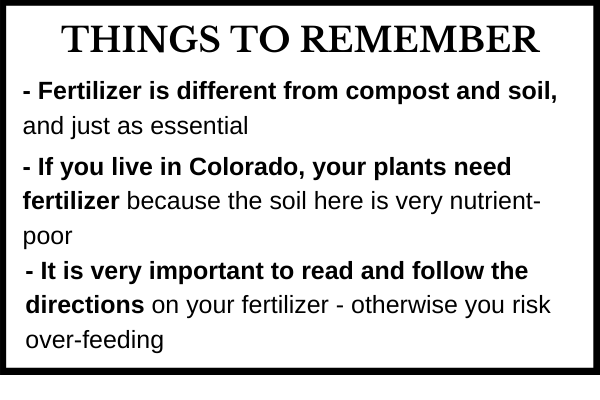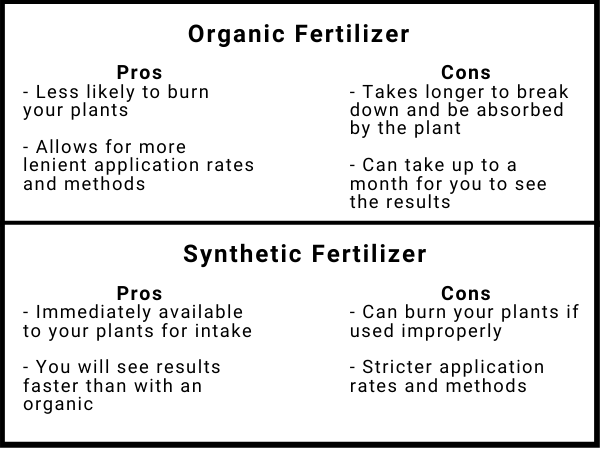Understanding Garden Fertilizers
The Basics
What is Fertilizer?
Fertilizer is best described as plant food. It provides a plant with all the necessary micro and macro-nutrients it needs to grow. Like us, a plant without food will be able to survive for a while, but it will eventually require sustenance to thrive. It should be noted that compost and soil are different from fertilizers and your plants will not get enough nutrients from soil and compost alone.
Do I even need fertilizer?
The answer – if you live and grow in Colorado – is a resounding “Yes!” The soil in Colorado is naturally very nutrient-poor, and these nutrients are essential for healthy, vibrant gardens. Even if you are planting in a raised bed or container garden, fertilizer is necessary for successful gardening.
When should I fertilize?
Fertilizing should be done on a consistent basis while a plant is out of dormancy (whenever it is actively growing). Depending on the type of fertilizer you choose, you can feed your plants anywhere between every watering or two to three times throughout the growing season. It is very important to read and follow the directions and dosages on your fertilizer carefully.

Understanding Your Options
What are the numbers?
Every fertilizer is required to display three numbers. These numbers are called the NPK – (N) for nitrogen, (P) for phosphorus, and (K) for potassium. These numbers represent the guaranteed amount of each macronutrient present in the fertilizer. For example, a fertilizer labelled “4-6-2” has 4% nitrogen, 6% phosphorus, and 2% potassium.
What do these nutrients do?
Luckily, there is an easy way to remember the purpose each of these macronutrients serve: Up – Down – All-around.
Up – Nitrogen will encourage lush, leafy growth above ground
Down – Phosphorus helps with strong root establishment and blooms
All-Around – Potassium supports the plant’s overall health and resistance to pests and disease.
Organic or synthetic?
There are pros and cons to both organic and synthetic products. Understanding them can help you decide what is best for your garden and gardening habits. Both organic and synthetic fertilizers will provide your plants with the same types of nutrients, and will not make a difference in the chemical make-up of the finished product.

Making the Decision
What is the right choice for my garden?
First, you must ask yourself what you want out of your garden – are you hoping for vibrant colors and large blooms from your annuals and perennials? Lush, dark green coverage from your foliage? Enough home-grown veggies to fill the fridge and give out to the neighbors? Once you decide your goal, picking a fertilizer is easy.
For foliage and leafy veggies, choose a fertilizer with a high nitrogen number (the first number of your NPK). Nitrogen encourages a plant to produce a lot of leaves. This will help give your annual and perennial beds a full, healthy look and will allow your lettuce, kale, and herbs to produce the most leaves possible.
For flowers, flowering vegetables, and root vegetables, you should ensure a high amount of phosphorus (the second number in your NPK). This will help the plant establish a healthy, extensive root system and will encourage the biggest, brightest, and most blooms possible.
*For tomatoes, you want a high phosphorus number to encourage bloom count, but you also want to ensure your tomatoes get enough calcium. Providing your tomatoes with extra calcium during planting and throughout the growing season will protect them from blossom-end rot (a disorder caused by a calcium deficiency in the plant).
*Please note, adding eggshells to your soil will not aid in avoiding blossom-end rot as the calcium in eggshells takes upwards of six years to break down and become “digestible” to the plant. Many fertilizers labelled specifically for tomatoes will have added calcium that is immediately available to your plants.
Back to Blog